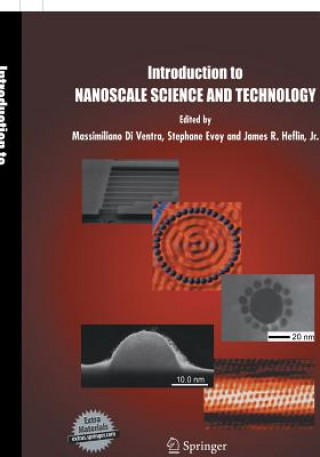
Kod: 01418153
Introduction to Nanoscale Science and Technology
Autor Massimiliano di Ventra, Stephane Evoy, James R. Heflin
From the reviews:§"...A class in nanoscale science and technology is daunting for the educator, who must organize a large collection of materials to cover the field, and for the student, who must absorb all the new concepts. This ... więcej
- Język:
 Angielski
Angielski - Oprawa: Twarda
- Liczba stron: 611
Wydawca: Springer-Verlag New York Inc., 2004
- Więcej informacji o książce

Zobacz książki o podobnej tematyce
Podaruj tę książkę jeszcze dziś
- Zamów książkę i wybierz "Wyślij jako prezent".
- Natychmiast wyślemy Ci bon podarunkowy, który możesz przekazać adresatowi prezentu.
- Książka zostanie wysłana do adresata, a Ty o nic nie musisz się martwić.
Więcej informacji o Introduction to Nanoscale Science and Technology
Za ten zakup dostaniesz 495 punkty
 Opis
Opis
From the reviews:§"...A class in nanoscale science and technology is daunting for the educator, who must organize a large collection of materials to cover the field, and for the student, who must absorb all the new concepts. This textbook is an excellent resource that allows students from any engineering background to quickly understand the foundations and exciting advances of the field. The example problems with answers and the long list of references in each chapter are a big plus for course tutors. The book is organized into seven sections. The first, nanoscale fabrication and characterization, covers nanolithography, self-assembly, and scanning probe microscopy. Of these, we enjoyed the section on nanolithography most, as it includes many interesting details from industrial manufacturing processes. The chapter on self-assembly also provides an excellent overview by introducing six types of intermolecular interactions and the ways these can be employed to fabricate nanostructures. The second section covers nanomaterials and nanostructures. Out of its 110 pages, 45 are devoted to carbon nanotubes. Fullerenes and quantum dots each have their own chapter that focuses on the properties and applications of these nanostructures. Nanolayer, nanowire, and nanoparticle composites of metals and semiconductors are briefly covered (just 12 pages), with slightly more discussion of specific applications. The section on nanoscale electronics begins with a history of microelectronics before discussing the difficulties in shrinking transistor size further. The discussion of problems (leakage current, hot electrons, doping fluctuations, etc.) and possible solutions (high- k dielectrics, double-gate devices) could easily motivate deeper discussions of nanoscale electrical transport. A chapter on molecular electronics considers transport through alkanes, molecular transistors, and DNA in a simple, qualitative manner we found highly instructive. Nanoscale magnetic systems are examined in the fourth section. The concept of quantum computation is nicely presented, although the discussion of how this can be achieved with controlled spin states is (perhaps necessarily) not clear. We found the chapter on magnetic storage to be one of the most lucid in the book. The giant magnetoresistive effect, operation of spin valves, and issues in magnetic scaling are easier to understand when placed in the context of the modern magnetic hard disk drive. Micro- and nanoelectromechanical systems are covered with an emphasis on the integration of sensing, computation, and communication. Here, the student can see advanced applications of lithography. The sixth section, nanoscale optoelectronics, describes quantum dots, organic optoelectronics, and photonic crystals. The chapter on organic optoelectronics is especially clear in its discussion of the fundamentals of this complicated field. The book concludes with an overview of nanobiotechnology that covers biomimetics, biomolecular motors, and nanofluidics. Because so many authors have contributed to this textbook, it suffers a bit from repetition. However, this also allows sections to be omitted without any adverse effect on student comprehension. We would have liked to see more technology to balance the science; apart from the chapters on lithography and magnetic storage, little more than an acknowledgment is given to commercial applications. Overall, this book serves as an excellent starting point for the study of nanoscale science and technology, and we recommend it to anyone with a modest scientific background. It is also a great vehicle to motivate the study of science at a time when interest is waning. Nanotechnology educators should look no further." (MATERIALS TODAY, June 2005)
 Szczegóły książki
Szczegóły książki
849.62 zł
- Pełny tytuł: Introduction to Nanoscale Science and Technology
- Autor: Massimiliano di Ventra, Stephane Evoy, James R. Heflin
- Język:
 Angielski
Angielski - Oprawa: Twarda
- Liczba stron: 611
- EAN: 9781402077203
- ISBN: 1402077203
- ID: 01418153
- Wydawca: Springer-Verlag New York Inc.
- Waga: 1138 g
- Wymiary: 263 × 189 × 38 mm
- Data wydania: 30. June 2004
Ulubione w innej kategorii
-

Dune
34.84 zł -33 % -

Haunting Adeline
125.81 zł -1 % -

Berserk Deluxe Volume 2
212.65 zł -1 % -

White Nights
15.30 zł -23 % -

Powerless
48.75 zł -11 % -

Atomic Habits
59.22 zł -26 % -

Dune Messiah
46.33 zł -3 % -

Berserk Deluxe Volume 3
218.19 zł -3 % -

One Day
32.63 zł -36 % -

Berserk Deluxe Volume 1
211.84 zł -2 % -

Iron Flame
61.14 zł -28 % -

Surrounded by Idiots
36.76 zł -28 % -

Harry Potter and the Prisoner of Azkaban (Minalima Edition)
170.44 zł -2 % -

Gravity Falls Journal 3
89.45 zł -

Heaven Official's Blessing: Tian Guan Ci Fu (Novel) Vol. 1
88.94 zł -1 % -

The Creative Act
100.22 zł -15 % -

Dune
47.34 zł -23 % -

Hunting Adeline
126.52 zł -4 % -

A Little Life
47.04 zł -14 % -

Children of Dune
46.73 zł -2 % -

Heaven Official's Blessing: Tian Guan Ci Fu (Novel) Vol. 2
77.76 zł -14 % -

Bungo Stray Dogs, Vol. 8 (light novel)
65.77 zł -4 % -

Percy Jackson and the Olympians 5 Book Paperback Boxed Set
185.55 zł -4 % -

Solo Leveling, Vol. 1
86.73 zł -3 % -

The Prisoner's Throne
44.92 zł -12 % -

Court of Thorns and Roses
43.41 zł -15 % -

Cry Baby Coloring Book
47.34 zł -1 % -

Fourth Wing
73.93 zł -12 % -

Icebreaker
35.15 zł -26 % -

Berserk Deluxe Volume 6
218.19 zł -3 % -

Avatar, the Last Airbender: The Kyoshi Novels (Box Set)
169.23 zł -2 % -

The 48 Laws of Power
100.93 zł -12 % -

House of Leaves
124.10 zł -3 % -

Twisted Lies
37.77 zł -26 % -

Dune Messiah
49.65 zł -13 % -

No Longer Human
58.52 zł -5 % -

48 Laws Of Power
61.14 zł -28 % -

Twisted Games
37.77 zł -26 % -

Caraval Paperback Boxed Set
175.58 zł -3 % -

Solo Leveling, Vol. 2
80.38 zł -17 % -

Open Circuits
169.63 zł -2 % -

Berserk Deluxe Volume 5
156.54 zł -30 % -

Heaven Official's Blessing: Tian Guan Ci Fu (Novel) Vol. 3
77.26 zł -14 % -

Berserk Deluxe Volume 4
201.36 zł -11 % -

Court of Mist and Fury
36.56 zł -26 % -

SOLO LEVELING V08
88.44 zł -2 % -

English File Upper Intermediate Multipack A (4th)
100.63 zł -

CHAINSAW MAN V14
42.70 zł -23 % -

Before the Coffee Gets Cold
33.94 zł -26 %
zadowolonych klientów
Od roku 2008 obsłużyliśmy wielu miłośników książek, ale dla nas każdy był tym wyjątkowym.
Copyright! ©2008-24 libristo.pl Wszelkie prawa zastrzeżonePrywatnieCookies






 21 milionów książek
21 milionów książek Dostawa 10.99 zł
Dostawa 10.99 zł (32) 444 93 66 (8-15.30h)
(32) 444 93 66 (8-15.30h)